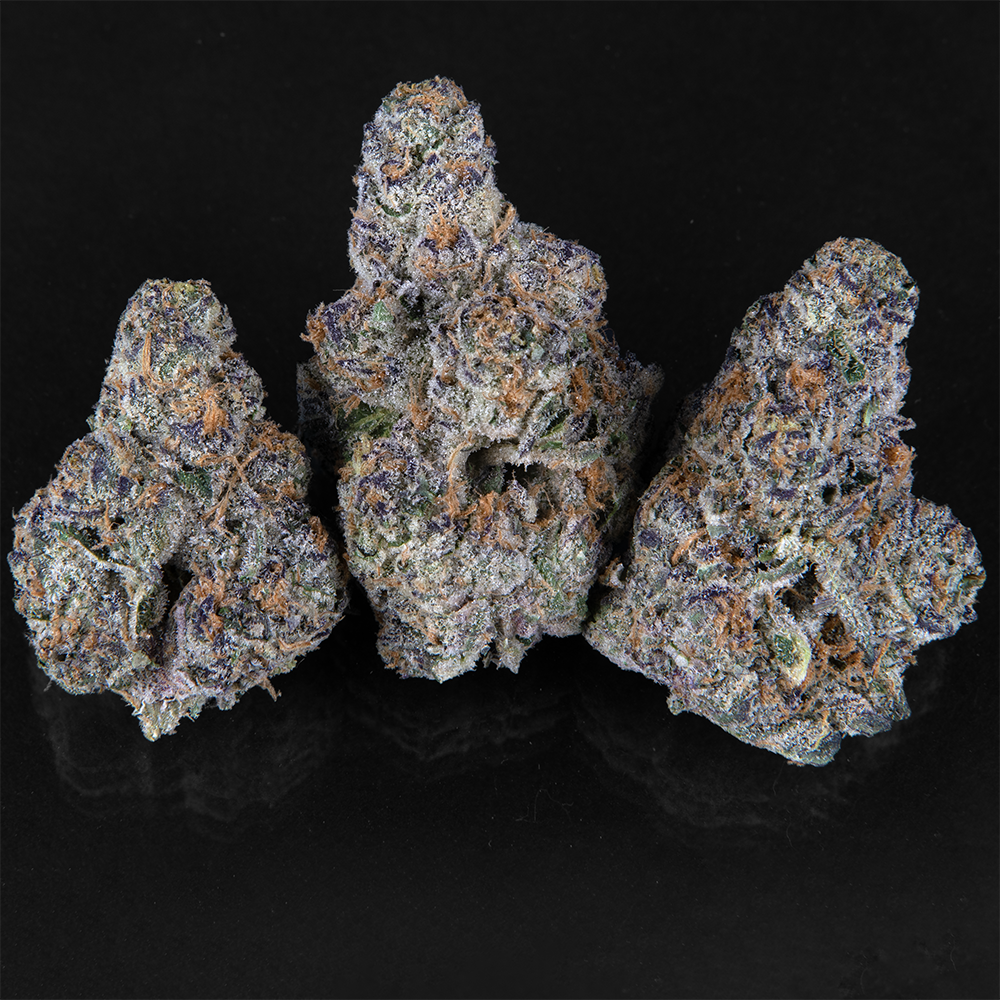Blue Cheese is a cross of two heavyweight strains- Blueberry and Cheese- each representing the best local varieties from their respective region, especially when it comes to their smells. Here’s how they got blended together into that funky Blue Cheese terpene profile:
Many legendary strains were born amidst the echoing yells of Pacific Northwest’s flannel-clad lumberjacks, but few showcase the region’s fruit and berry strains quite like DJ Short’s Blueberry. Known for body-slamming potency and its uncanny aroma and flavor, Blueberry has been around since the late 1970s, but it stayed popular long enough to win the Cannabis Cup in 2000, all the way over in Amsterdam!
About a decade after Blueberry hit the US scene, a funky pheno of Sensi Seeds’ Skunk #1 started making waves across the pond, in the land of tea and crumpets. The trend-setting smell? Rotten Cheese. That may seem surprising at first, especially given all their etiquette and fancy talk, but the Brits stick raw fish heads into pies for added flavor, so they seem to be enthusiasts for an “acquired taste”. That still doesn’t explain why, though, so what gives?
According to Mister Milo of Big Buddha Seeds, it’s actually because funky weed is the only thing that covers up the taste of tobacco they use to roll spliffs. The Brits actually liked that stinky Cheese pheno so much that ‘skunk’ and ‘cheese’ are basically the British words for ‘kush’ and ‘dank’.
Just like Blueberry in the Pacific Northwest, Cheese built up a foundation in the UK before exploding onto the European scene as an all-time favorite many years later. Although Skunk #1 was introduced to the area in the late 1980s, Big Buddha Seeds found their Cheese clone in 2002 and won their first Cannabis Cup with an improved version in 2006.
To make their Blue Cheese strain, they selected a Blueberry male after testing many different versions and used that Blueberry male to pollinate their in-house Big Buddha Cheese. Then they selected one of the fruitiest males from the Blueberry x Big Buddha Cheese cross and used that to pollinate their Big Buddha Cheese.
The resulting Blue Cheese strain has a terpene profile that fuses is an intercontinental fusion of two very different relics from the only two places where people think IPAs actually taste good (when the regional favorites are fish head pie and cauliflower “buffalo wings”, we get it).

BLUE CHEESE GENETICS:
Vintage: mid 2000s
Breeder: Big Buddha Seeds
Lineage: Big Buddha Cheese (female) x [DJ Short’s Blueberry x Big Buddha Cheese](male)
BLUE CHEESE EFFECTS: The Blue Cheese strain has a slow onset of physical relaxation without an immediate head rush. It’s mellow and stress-relieving effects aren’t incapacitating at smaller doses but can still help with insomnia and pain. The clear-headed and focused euphoria gives it a wide appeal that works well in almost any situation.
BLUE CHEESE MEDICAL Benefits: Blue cheese is a euphoric strain that can alleviate depression and anxiety but doesn’t lack the power to help patients with moderate pain or other physical ailments. Although some report it to be an effective daytime smoke, it’s generally recommended as an after work or nighttime pick-me-up that doesn’t keep a person from relaxing or falling asleep.
Common side effects include red eyes, dry mouth, and the munchies.
BLUE CHEESE CHARACTERISTICS: The large, dense, and resinous buds of the Blue Cheese strain produce thick smoke that tickles the lungs. The underlying muskiness of its aroma stays true to its pungent Cheese lineage, but with Blue Cheese the funk comes balanced by the smell of sweet fruits and tart berries. A more tart blueberry flavor comes through with clarity when exhaled, but only for a moment. Finally, Blue Cheese will linger on the tastebuds with a musty, earthy aftertaste.
BLUE CHEESE STRAIN TERPENE PROFILE: Blue cheese has medium to high THC with a terpene profile dominated by beta caryophyllene and supplemented by limonene, humulene, mycerene, linalool, and alpha bisabolol. A chart of the True Terpene profile can be found here. However, since the Blue Cheese strain isn’t famous for only one phenotype, there are other blue cheese terpene profiles you may encounter. For example, Eybna’s formulation Blue Cheese terpene profile is dominated by myrcene and pinene as the primary components.
BLUE CHEESE AWARDS AND OTHER INFO: Blue Cheese won 3rd place at the 2006 High Times Cannabis Cup for Best Sativa Seedbank. Since then, Big Buddha Seeds has become the world’s cheese-daddy and they’ve got a whole line up of other strains, including many that don’t smell like the inside of a garbage dumpster. For more on the Afghani landrace they use for breeding, see this blog post on their website.
GROWING BLUE CHEESE AND BLUE CHEESE SEEDS: Blue Cheese takes between 56-70 days to mature in flowering. For the best of it’s hallmark flavor, Big Buddha seeds recommends growing Blue Cheese in soil. The Blue Cheese strain yields a large bounty of dense nuggets that will sometimes finish purple. Blue Cheese does have a High leaf to calyx ratio and will likely require some pruning and significant trim time.
You can also check out Big Buddha’s advice on home growing in this blog post and Blue Cheese seeds, as well as the rest of their lineup, can be found at their website.
BLUE CHEESE AUTO STRAIN SEEDS: If it’s an autoflowering Blue Cheese that your heart desires, you’re in luck! Big Buddha Seeds offers their Blue Cheese Automatic in five packs and ten packs.
Although we’re always wary of strain recreations, it’s hard to brush off Kyle Kushman as a mere knock-off. His new seed company, Homegrown Cannabis Co, bred their own Blue Cheese auto strain and it may be worth checking out for those interested in a slightly more relaxing, sedative version of Blue Cheese.
